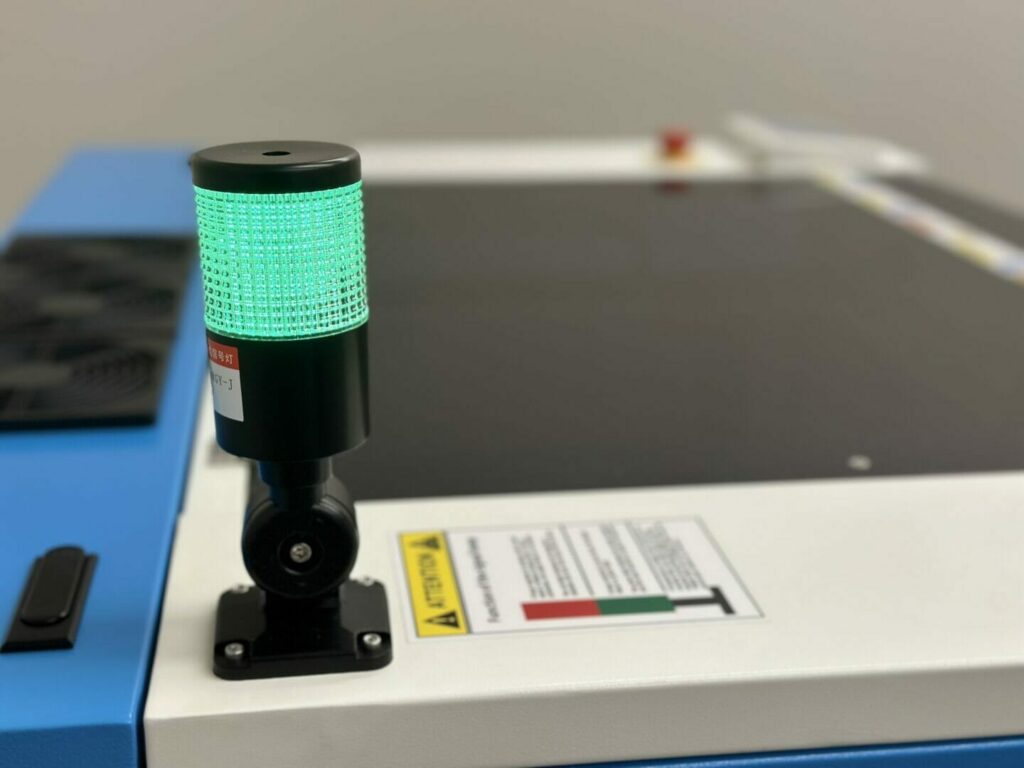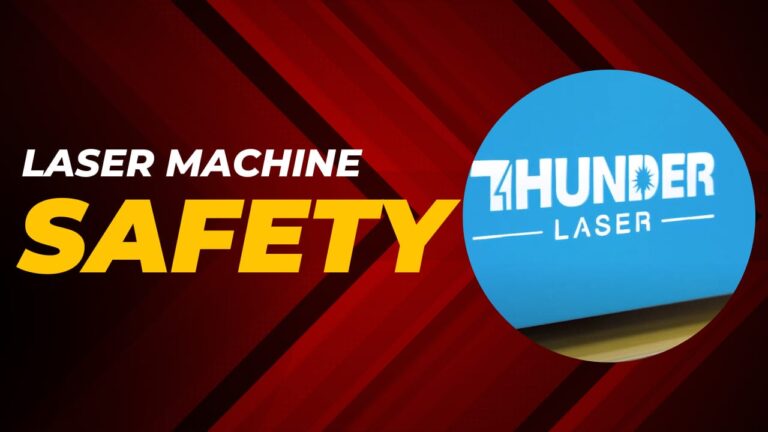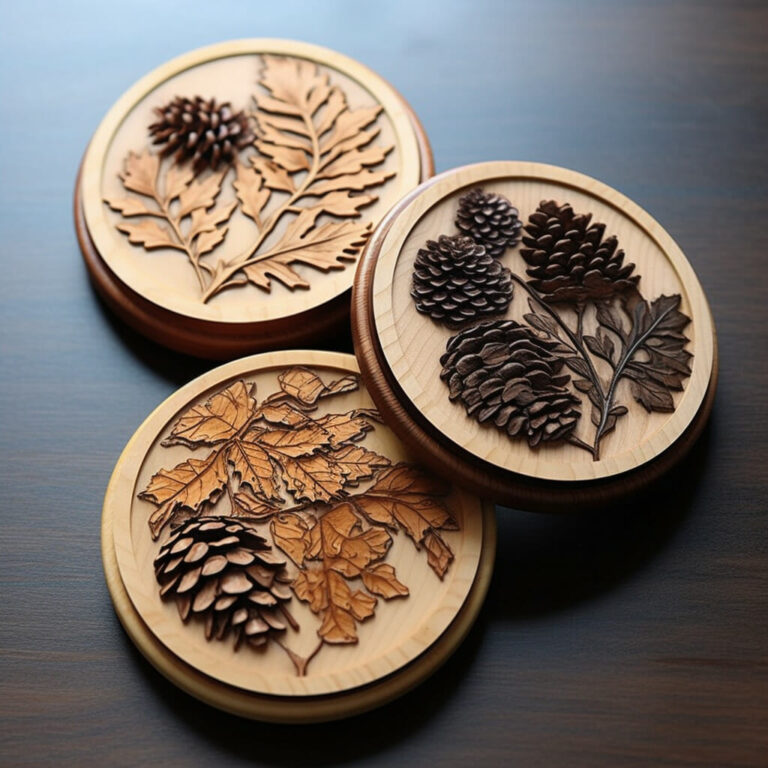Selecting the right material for your laser engraving projects is essential for achieving the desired results. In this blog post, we will explore some of the most popular materials for laser engraving. We will also provide tips on choosing the best material for each project, ensuring your creations stand out and impress.
Wood
Wood is an excellent material for laser engraving due to its natural beauty and versatility. Engraving wood can create stunning pieces of art and personalized gifts that will be cherished for years to come. Wood types vary in characteristics like color, grain, and hardness, affecting the engraving outcome. Here are some tips for choosing the right wood for your project.
Opt for hardwoods like maple, cherry, or walnut for a more consistent and precise engraving result. These types of wood have a tight and uniform grain, which makes them ideal for detailed engravings. Hardwoods are also more durable and less likely to warp or crack, ensuring that your engravings will last a long time.
Softwoods like pine or cedar can be engraved, but their softer nature may result in less precision. These woods have a more open and irregular grain pattern. This can cause the laser beam to scatter and create a fuzzy or blurry image. However, softwoods can be an excellent choice if you’re looking for a rustic or vintage look.
When choosing wood for your project, it’s important to consider the thickness of the material. Thicker wood pieces can handle deeper and more detailed engravings, while thinner pieces are better options for simpler designs. It’s also important to choose wood that is free of knots or other imperfections, as these can affect the quality of the engraving.
Before starting your project, it’s crucial to test a small area of the wood to ensure you get the desired effect. This will help you avoid any surprises or mistakes and allow you to adjust the engraving settings if necessary. It’s also a good idea to consider the orientation of the wood grain when engraving, as this can affect the overall appearance of the engraving.
In addition to traditional woods, there are also other wood-based materials that can be good choices for laser engraving. Plywood, for example, is a popular choice due to its affordability and versatility. Plywood consists of layers of wood veneer glued together, which can create a unique and interesting look when engraved.
Overall, wood is an excellent material for laser engraving, and by choosing the right type of wood for your project, you can create stunning and personalized pieces that will last for years to come.
Acrylic
Acrylic is a highly versatile and well-suited when it comes to laser engraving materials. It offers a range of benefits, making it a popular choice for various projects. It is durable, lightweight, and easy to cut, making it an ideal material for signage, display cases, awards, and other products that require clean, intricate designs.
When selecting acrylic for your project, it is important to consider a few key factors to ensure the best results. One important consideration is the type of acrylic you choose. Cast acrylic is generally preferred over extruded acrylic for laser engraving, as it provides a cleaner and more polished finish. This is because cast acrylic is formed by pouring liquid acrylic into molds, resulting in a more uniform structure and less stress on the material than extruded acrylic, which is formed by pushing melted acrylic through a die.
Another consideration when working with acrylic is the color of the material. While clear or white acrylics are generally the best choice for laser engraving, colored acrylics can also be used with some limitations. It is important to keep in mind that some colors may not engrave as clearly as others, and the engraving may appear less visible or blurry. Before starting your project, it is a good idea to test a small area of the acrylic to ensure the desired effect is achieved.
To achieve the best results with acrylic, it is also important to experiment with different power and speed settings on your laser engraver. Depending on the thickness and density of the acrylic, different settings may be required to achieve the desired effect. Generally, lower power and higher speed settings are recommended for engraving acrylic, as this can help prevent melting or warping of the material.
When designing your engraving project with acrylic, it is also important to consider the thickness of the material. Thicker acrylic can be more difficult to engrave, as it requires more power and can be prone to melting or warping. Thinner acrylics, on the other hand, may be more delicate and require more careful handling during the engraving process.
In summary, acrylic is a popular and versatile material for laser engraving, offering a range of benefits including durability, affordability, and the ability to create intricate designs with clean edges. When selecting acrylic for your project, it is important to consider factors such as the type and color of the material, as well as experimenting with different power and speed settings to achieve the best results. By taking the time to carefully consider these factors, you can ensure that your acrylic engraving project is a success.
Glass
Glass engraving can add a unique touch of elegance to any item, from glassware to awards and decorative pieces. However, due to the fragile nature of glass, engraving can be more challenging than other materials. With a few key tips and techniques, you can achieve stunning results without damaging the glass.
First and foremost, it’s important to use a lower power setting and higher engraving speed when working with glass. This helps to prevent cracking or shattering the glass, which can ruin your project. Be sure to adjust your laser engraver settings accordingly to ensure optimal results.
In addition, it can be helpful to apply a wet paper towel or masking tape to the surface of the glass before engraving. This helps to reduce heat buildup and can result in a more consistent and precise engraving. Be sure to test this technique on a small section of the glass before proceeding with your project, as the wet paper towel or tape can affect the engraving outcome.
Another important tip is to practice on scrap pieces of glass before working on your final project. This allows you to perfect your technique and adjust your settings as needed without the risk of ruining your final piece. Once you feel confident in your abilities, you can move on to your final project with greater ease and precision.
When choosing glass for your engraving project, keep in mind that not all types of glass are suitable for engraving. Look for glass that is specifically designed for laser engraving, as this will provide the best results. It’s also a good idea to choose a thicker piece of glass, as this will be less likely to crack or shatter during the engraving process.
Overall, with careful consideration and practice, glass can be a stunning material for laser engraving. Be sure to take the necessary precautions to avoid damaging the glass, and experiment with different techniques and settings to achieve your desired result.
Metal
Engraving on metal is quite common, typically in projects such as to personalize jewelry, commemorate an event, or label tools and equipment. It is a perfect option for a variety of projects that require durability and longevity. However, there are certain considerations you should take into account before engraving on metal to achieve the best results.
One of the most important factors to consider when engraving metal is the type of laser you use. The two most commonly used lasers for engraving on metal are fiber lasers and CO2 lasers with a specialized marking compound. The former utilizes a high-powered laser beam focused on the metal surface for a permanent mark. The latter creates a chemical reaction on the metal surface, also leaving a permanent mark.
Another important consideration when engraving on metal is the power, speed, and frequency settings of your laser engraver. The settings depend on the type of metal, engraving depth, and the size of the design. Typically, you will use lower power settings for lighter metals like aluminum, while you will use higher power settings for heavier metals like stainless steel. Adjusting the speed and frequency settings can also affect the clarity and depth of the engraving, so it’s essential to experiment with different settings to find the optimal combination.
Before engraving on metal, it is crucial to clean the metal surface thoroughly to ensure a crisp, clear result. Any dirt or debris on the surface can interfere with the engraving process and cause the mark to be less precise. To clean the surface, use a mild detergent or solvent and a soft cloth to remove any dirt or grime. Rinse the surface thoroughly with water and dry it completely before proceeding with the engraving process.
In addition to these considerations, it is also essential to choose the right type of metal for your project. Some metals, like gold and silver, are more delicate and require extra care to prevent damage during the engraving process. On the other hand, heavier metals like brass and steel require more power and a different approach to achieve the desired result.
In conclusion, engraving on metal is an excellent option for projects that require durability and longevity. However, achieving the best results requires considering factors like the type of laser and power settings. Additionally, cleaning and metal type are important considerations. With the right approach, engraving on metal can create a beautiful and personalized result that is sure to impress.
Factors to Consider When Choosing Materials
Choosing the right material is crucial to the success of your laser engraving project. There are many factors to consider when selecting the best material for your project, including the intended purpose, durability, and budget.
Firstly, you should consider the intended purpose of your project. Consider wood, acrylic, or glass for decorative pieces; they offer a unique and elegant laser-engraved look. For functional items, durable materials like metal or plastic are preferable to withstand frequent use. Now if it’s a gift, you may want to choose a material that has sentimental or personal significance, such as a piece of jewelry made of silver or gold.
Another factor to consider is durability. Some materials are more durable than others and are better choices for certain applications. For example, if you plan to engrave a sign that will be outdoors, consider using metal or high-density plastic. These materials can withstand weathering. On the other hand, if you’re creating a ‘hands-off’ decorative item, you may be able to use a more delicate material such as glass or acrylic.
Budget is also an important consideration when choosing materials. Some materials, such as certain hardwoods or metals, can be more expensive than others. However, it’s important to remember that the material you choose can have a significant impact on the quality of your project. Choosing a cheaper material that doesn’t suit your needs may result in a finished product that doesn’t meet your expectations.
Ultimately, the best material for your laser engraving project will depend on a variety of factors, including the intended purpose, durability, and budget. Take the time to consider these factors carefully and choose a material that will help you achieve your desired outcome.
Conclusion
Laser engraving allows creating unique designs on various materials with versatility and innovation. Choose the right materials for your laser engraving projects to achieve desired results. Select compatible materials and consider their unique properties for stunning and professional-quality pieces.
Wood is a popular material for laser engraving due to its natural beauty and versatility. Different types of wood offer varying characteristics, such as color, grain, and hardness, which can affect the engraving outcome. Hardwoods like maple, cherry, walnut allow precise and consistent engravings; softwoods like pine, cedar need caution.
Acrylic is popular for laser engraving due to its durability, affordability, and intricate design capabilities. Choose cast acrylic for a cleaner finish; experiment with power and speed settings for colored acrylics. Apply a wet paper towel or masking tape to glass surface to reduce heat and ensure consistency.
Glass provides a unique, elegant look when laser engraved, ideal for awards, gifts, and décor. However, engraving glass can be more challenging due to its fragile nature. Use lower power and higher engraving speed for best glass engraving results, preventing cracking or shattering. Consider applying a wet paper towel or masking tape to the glass surface before engraving to reduce heat and produce a more consistent result. Practice on scrap pieces of glass before working on your final project to perfect your technique.
Metal is a durable and versatile material for laser engraving, but it requires specific considerations to achieve the best results. Use a fiber laser or CO2 laser with specialized marking compound to engrave metals like stainless steel, aluminum, or brass. Adjust the power, speed, and frequency settings on your laser engraver to achieve the desired depth and clarity. Clean the metal surface thoroughly before engraving to ensure a crisp, clear result.
When selecting the best material for your laser engraving project, consider the following criteria:
- The intended purpose of the project
- Durability of the material
- Your budget
By considering factors and selecting materials carefully, you can create stunning and professional-quality laser engravings. With the right materials, your laser engraving projects will stand out and leave a lasting impression.




